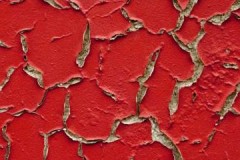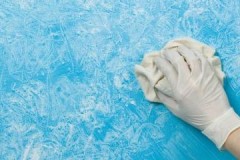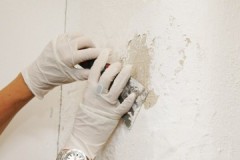Proven ways to easily remove paint from kitchen walls
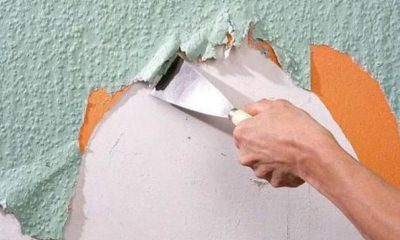 Removing paint from kitchen walls is difficult. However, if you make some effort and put into practice the advice of specialists, then a person will be able to cope with this problem without any experience in repair work.
Removing paint from kitchen walls is difficult. However, if you make some effort and put into practice the advice of specialists, then a person will be able to cope with this problem without any experience in repair work.
Both classic tools in the form of a spatula or chisel, and unusual devices, such as an iron and foil, can help in the fight against paint.
More about how to remove paint from walls in the kitchen, we will tell in the article.
Content
How do I remove old paint?
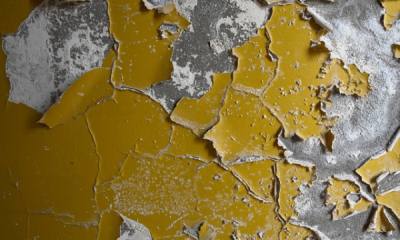 There are several ways to delete paint from kitchen walls:
There are several ways to delete paint from kitchen walls:
- Mechanical cleaning using special tools such as a spatula or hammer drill.
- Chemical paint removal using washes.
- The thermal method, which is implemented by heating the wall with a building hair dryer, iron or blowtorch.
Each method has its own advantages and disadvantages, which you need to familiarize yourself with before starting work.
Spatula
The spatula copes well with paint that has already begun to peel off and fall off. If it fits snugly against the wall, then getting rid of it using this tool will be problematic.
Advantages of using a spatula:
- dust does not form during operation;
- it is possible to remove paint even in the most inaccessible places, for example, in corners or near outlets;
- the walls will be cleaned properly.
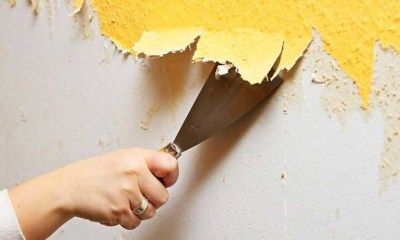 The disadvantages of the method include:
The disadvantages of the method include:
- labor intensity;
- the need for physical strength;
- slow speed of work.
If a large wall is to be cleaned, the trowel may become dull. Sandpaper helps to make it sharper.
Removal can be facilitated by using notches... They are made all over the wall, after which it is moistened with water and left until completely absorbed.
Thanks to this treatment, the cleaning of the paint will go faster. If a spatula was not found in the house, it can be replaced with a chisel.
Using chemicals
You can use special solvents to remove paint. They are sold in home improvement stores and online.
To facilitate the work and better penetration of the composition into the paint, you can first clean the walls with sandpaper or a metal brush. Surfaces that do not need cleaning should be protected with polyethylene. You need to work carefully, avoiding contact with caustic compounds on the skin and mucous membranes.
Advantages of the chemical method:
- Ease of use.
- Fast paint removal.
- High-quality cleaning of the walls in the kitchen.
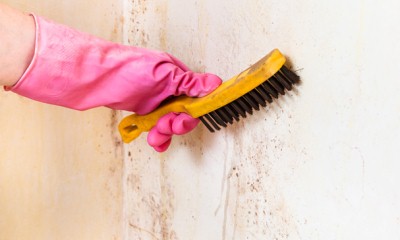 Disadvantages of using chemicals:
Disadvantages of using chemicals:
- The appearance of a pungent odor.
- The need for long-term airing of the room, which can be problematic in the cold season.
- The need for proper disposal of chemical residues. This information should be indicated on the packaging.
- Purchase spending.
Reagents can be made on the basis of alkali, acid or organic substances. If a old paint, then preference should be given to alkaline solutions.
Most popular remedies to remove paint from walls:
- Liquid formulations: Flay-5 remover, Antikras, Docker S4, V33,
- Gels: Body 700, Prestige.
- Aerosols: Paint Remover, Kudo remover.
The average cost of a wash is 600-700 rubles.
With a hammer and an ax
A section of densely painted wall can be dealt with with an ax or a hammer and chisel. The selected tool should not be too sharp or blunt. You need to act carefullyto avoid injury.
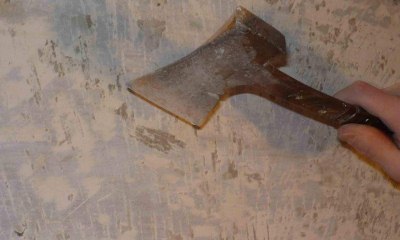 Notches are made with an ax. They should be located at a distance of about 10 cm from each other. Cleaning is done with the tip of the tool, keeping it parallel to the wall surface.
Notches are made with an ax. They should be located at a distance of about 10 cm from each other. Cleaning is done with the tip of the tool, keeping it parallel to the wall surface.
Basic steps to remove paint with an ax:
- notching;
- wetting the wall with warm water - leave it on the wall surface for 5 minutes;
- removal of paint.
The advantages of the method:
- lack of financial costs;
- ease of use.
To work more conveniently, you need to take a small, lightweight ax.
Disadvantages of the method:
- labor intensity;
- time costs;
- violation of the integrity of the wall.
Areas located near the outlets must be cleaned with a chisel, which is gently tapped with a hammer.
Using a puncher
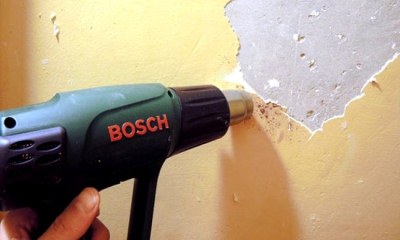 Removal instructions paint from the kitchen wall using a punch:
Removal instructions paint from the kitchen wall using a punch:
- Connect the instrument to the network.
- Bring it to the wall, holding it tangentially.
- Adjust the appropriate combat speed. The blows should be superficial but strong.
- Clean the wall regularly from paint.
You need to work with gloves and goggles.
Advantages of the method:
- Rapidity.
- High-quality work performance. With a punch, you can easily get rid of several layers of paint.
- Little physical effort.
The main disadvantages of working with a puncher:
- Loud noise.
- The appearance of a significant amount of dust and debris.
- The need to search for a tool, since a hammer drill is not in every home.
- Potential for wall damage. It rises in the absence of experience with the instrument.
Thermal methods
You can get rid of paint using high temperatures. For this purpose, use:
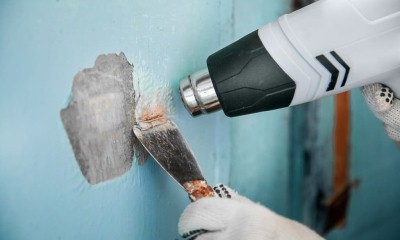 Building hair dryer... A jet of hot air is directed to the treated area. When the paint begins to melt, remove it with a spatula or construction spatula.
Building hair dryer... A jet of hot air is directed to the treated area. When the paint begins to melt, remove it with a spatula or construction spatula.- Iron. The device is plugged in and heated. Then they are passed along the wall, through a sheet of foil. The softened paint is removed with a scraper.
- Blowtorch... The flame is brought as close to the wall as possible. When the paint begins to melt, it is peeled off.You need to work carefully to prevent fire.
The thermal method of removing paint is always accompanied by the appearance of a pungent odor. therefore the procedure can only be carried out in rooms that are well ventilated.
It is forbidden to warm up those sections of the wall where wires or wooden elements are located.
How to remove different types of paints and varnishes?
Depending on the type of paint, the recommendations for its removal differ:
- Water emulsion paint. You can get rid of it using any of the listed methods. However, before carrying out the procedure, the wall must be well moistened, this will make it easier to get rid of the coating. Most often, it is possible to do without the involvement of heavy equipment in the form of a hammer drill or drill. Walls can be cleaned well with a spatula.
- Acrylic paint. It can be removed well with acetone based solvents.
- Oil paint. You can cope with it mechanically. This is especially true when the paint is applied to the wall in several layers.
If you are not sure which paint is applied to the wall, it is recommended to choose a universal paint remover.
This could be:
- Syntilor remover (1,700 rubles for 5 kg);
- Kudo (170 rubles for 520 ml);
- Docker (1900 rubles for 4.5 kg);
- others.
The most common mistakes
When trying to remove old paint from the wall, people most often make the following mistakes:
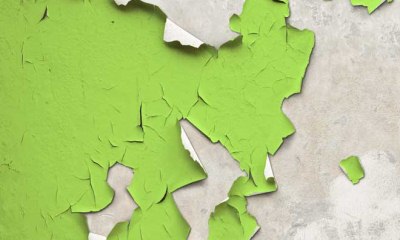 Too active work with the tool. This leads to damage to the wall, which will be very difficult to align in the future.
Too active work with the tool. This leads to damage to the wall, which will be very difficult to align in the future.- Incorrect selection of a hammer drill bit. It is recommended to use a special nozzle to remove paint, otherwise the wall can be damaged.
- Heating a wall near power outlets or other flammable items. This is a serious error that can cause a fire.
- The use of chemicals without the use of a respirator. If you do not protect the respiratory system, then the likelihood of poisoning is extremely high.
The safest way to remove paint from kitchen walls is by mechanical cleaning. There is no risk of fire during such processing, and no harmful substances are released into the air.
This is especially true for the room in which food is stored and the cooking process is carried out.
Advice
To remove paint from the walls it is recommended to use the following recommendations:
- For mechanical cleaning, such as a spatula, eyes are protected with construction goggles or a mask.
- Wear a respirator when using chemicals. Hands should be protected with gloves.
- After applying the wash, the room is thoroughly ventilated. Any sources of fire and heat should be kept away from the work area.
- To facilitate the subsequent cleaning and not damage the floor covering, it is recommended to protect it with plastic wrap.
Related Videos
The easiest and fastest way to remove paint from a wall in a video:
Conclusion
You can remove paint from the walls using any of the above methods. The main thing is to follow the sequence of actions and protect yourself from injury..
Failure to work safely with heating tools or chemicals can result in property damage, fire and even serious health problems. Therefore, experts recommend using a mechanical cleaning method. It is time consuming, but the safest.

